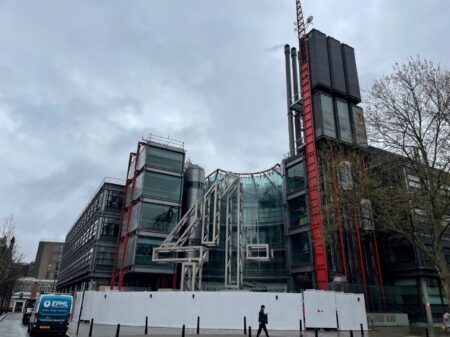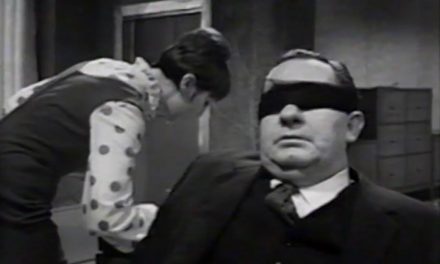On Monday evening 4 April, the UK Culture Secretary Nadine Dorries tweeted that she intended to push ahead with the privatisation of Channel 4. Twitter is her favourite medium. She also tweeted her decision, before any negotiations, to freeze the BBC’s licence fee for two years, a real terms cut of £2 billion. Her contention about Channel 4 was simple: it needs to compete directly with Netflix and Amazon, but is constrained by ‘public ownership’ from raising the capital needed to do so. Channel 4 News duly reported this, but Netflix News did not, since as we all know Netflix does not have a news service… and therein lies the problem with Dorries’ argument.
Channel 4 rightly holds a cherished place in British life and I want that to remain the case. I have come to the conclusion that government ownership is holding Channel 4 back from competing against streaming giants like Netflix and Amazon. 1/3
— Rt Hon Nadine Dorries (@NadineDorries) April 4, 2022
Channel 4 is an advertising funded public service broadcaster for the UK, with a full range of TV genres. Netflix and its fellow streamers (Amazon, Apple, Disney+ etc) are globalised subscription-funded entertainment services specialising in drama series and films. Rather than competition, there appears to be complementarity: they are different services providing different things. Channel 4 has its own streaming service, All4, which boasts that it is the biggest free streaming service in the UK, and that too is advertising funded (with a subscription option to watch ad-free).
Despite what the Culture Secretary appears to believe, Channel 4 has never cost the Treasury a penny since it opened in 1982. So is it really the government’s property to sell? Legally it may be, but morally it certainly is not. Channel 4 is owned by the state in trust for the people of the UK, rather than being a state enterprise.
Channel 4 is part of a wide range of public spaces held in trust by the state, which includes public parks and playing fields, roads, footpaths and rights of way. The past thirty years have seen a progressive erosion of these spaces at all levels of government from local to national. Parks and allotments have been eroded, sold off to developers, along with an astonishing 70% of the NHS estate. Usually there is a backstairs deal between local authorities and developers which appear to ‘reinstate’ some public space, but in fact privatise them as POPS, private open spaces.
The privatisation of Channel 4 is just a virtual version of this trend. Nadine Dorries and John Whittingale’s specious argument is just the same as that of a local authority: they claim that the public space can only be improved with the injection of capital from a private company, capital that the state itself cannot provide, or rather chooses not to provide.
This argument is just a cover for the sale of assets, usually at a knock-down price. So-called public-private partnerships rebuild entire estates of public housing as massive blocks of apartments for sale with a few ‘social housing’ units tucked away in an undesirable corner. These few ‘social units’ are then trumpeted as a ‘planning gain’. The same process will happen when Channel 4 is privatised.
The new owner will consent to all kinds of restrictions and requirements in order to secure its purchase. After a couple of years that owner will return and say that unfortunately, as it turns out, some of these are too expensive to continue. Ofcom, the regulator will agree (did I mention that its new chair is Michael Grade, who has pushed for the privatisation of Channel 4?). Channel 4 News must be cut to half an hour and shunted off the 5pm. Unreported World will no longer be reported. The Paralympics must be banished to daytime. And the regulator will reluctantly agree because the financial arguments are incontrovertible. It is a familiar story from other privatised utilities like water, where sewage is too expensive to treat properly and leaking mains somehow cannot be replaced… all the while that the companies pay dividends to their shareholders, because that’s how the system has to work.
Except, of course, in the case of the remaining public assets like Channel 4. Held in trust for the polity of the so-called United Kingdom, Channel 4 retains all its profits for reinvestment. There are no shareholders requiring dividends and able to sell on their shares if they are not satisfied.
The state ownership of Channel 4 is an administrative convenience. In 1977 The Annan Committee proposed Tony Smith’s innovative model of a publisher broadcaster to diversify the duopoly of TV broadcasting that then existed. Channel 4 is called that because it was only the fourth TV channel ever to be set up in the UK.
State ownership was a legislative convenience that enabled this new kind of broadcaster to be born. It implied no state control of what was broadcast. It simply enabled the opening of a public space where hitherto silenced voices could be heard, and hitherto marginalised audiovisual work could be commissioned and circulated. It was a public space, run by a company that commissioned third parties (independent production companies) to provide those voices and works. It was an entirely new way of conceiving television, and it worked. Channel 4’s famous ‘remit’ is no different from the other charters and bequests that have set up public spaces to be safeguarded by the state. As the BBC’s current promotion of public service broadcasting puts it, “it belongs to all of us”
The creation of public rather than private spaces has a long history. Ironically, many of the public spaces that have now been privatised were donated by their then owners as acts of philanthropy. Successful Victorian entrepreneurs believed in giving something back to society, creating public assets that the state was not providing. Often they were motivated by their religious beliefs in doing so. They endowed hospitals and parks and even universities (like Royal Holloway where I work). And often they were Tories, the ancestors of the current Conservative Party.
There are still some conservatives, now in their 80s, who still hold these beliefs, people like Michael Heseltine or Norman Fowler, who led a successful campaign with David Puttnam to fight back the last attempt to privatise Channel 4. They are now marginalised within their own party, pushed aside by the younger inheritors of Thatcherism for whom private ownership is not balanced by any sense of philanthropy, social responsibility or religious duty. They are the true inheritors of Margaret Thatcher’s infamous dictum that “there is no such thing as society”.
These new conservatives also have another motive: a desire to destroy anything that is valued by the people that they see as ‘liberals’. A friend whose unfortunate task it is to lobby government on a number of issues recently told me: “never underestimate how much they hate people like you”.
Complicated legislation is required to move Channel 4 to the point where it can be sold with sufficient requirements to preserve its distinctive public service mission, at least in the short term. So there is a parliamentary fight ahead, and those have not gone the government’s way very easily in the recent past, despite their majority. The House of Lords has just sent back Priti’s Patel’s infamous Immigration bill for a second time, and it might run out of time before this Parliament is dissolved. It is two years before the date by which an election has to be held, so in the end Channel 4 may be saved by lack of legislative room. There is just that faint hope that this act of cultural vandalism will not take place.
Meanwhile, Channel 4 will celebrate 40 years as a public service broadcaster this November. In September, along with a BFI season of early programmes, there will be a conference Channel 4: Then and Now, please find the full Call for Papers here on CSTonline. There is still time to submit a paper to channel4conference@rhul.ac.uk
John Ellis is Professor of Media Arts at Royal Holloway University of London. He led the ADAPT project on ‘how TV used to be made’, funded by the European Research Council. He co-edited Hands On Media History (2020) with Nick Hall, and is the author of Documentary: Witness and Self-revelation(Routledge 2011), TV FAQ (IB Tauris 2007), Seeing Things (IB Tauris 2000) and Visible Fictions(1984). Between 1982 and 1999 he was an independent producer of TV documentaries through Large Door Productions, working for Channel 4 and BBC. He is chair of Learning on Screen and an editor-in-chief of VIEW, the online journal of European television history and culture. His publications can be found HERE.




